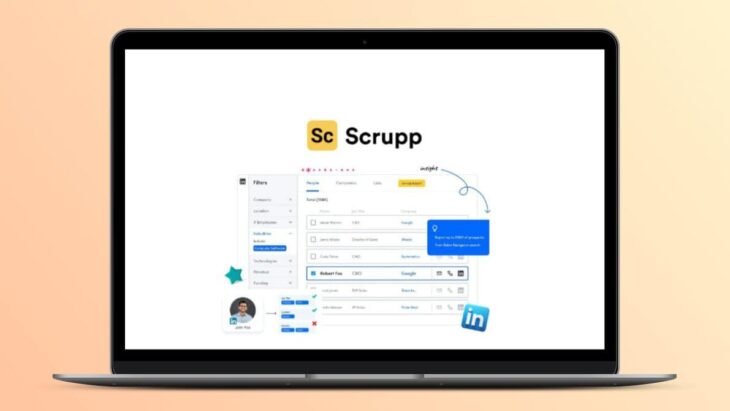In the realm of professional networking and career development, the digital landscape has been dominated by a few key players, with LinkedIn being one of the most recognized names.
However, as technology advances and user needs evolve, new platforms emerge, bringing innovative features to the forefront of networking. One such platform is Scrupp, which has been making waves with its advanced automation and unique approach to professional connection-building.
This article delves into the intricacies of Scrupp’s offerings, contrasting them with LinkedIn’s established services, to provide a comprehensive understanding of the current state and future possibilities in networking innovation.
The Evolution of Professional Networking Platforms
To appreciate the innovations brought forth by platforms like Scrupp, it’s crucial to understand the evolution of professional connection-building platforms.
Historically, these platforms began as simple online resumes and job boards but have since evolved into complex ecosystems offering a myriad of tools for career development, networking, content sharing, and more.
LinkedIn, for instance, has been at the forefront of this evolution, continually expanding its services to include features like learning resources, sophisticated job-matching algorithms, and interactive content creation tools.
Scrupp ─ A New Challenger Emerges

Enter Scrupp, a platform that takes a fresh approach to professional networking by leveraging advanced automations and AI-driven insights. Unlike traditional platforms, Scrupp emphasizes the automation of connection-building tasks, personalized content delivery, and proactive career opportunity identification.
This focus on automation and AI is designed to streamline the networking process, making it more efficient and tailored to individual user needs.
Advanced Automation in Networking
One of Scrupp’s standout features is its advanced automation capabilities. These automation go beyond simple task automation, offering users intelligent suggestions for networking opportunities, automated scheduling for meetings, and even AI-powered analysis of connection-building interactions to suggest improvements.
This level of automation is designed to reduce the manual effort involved in networking, allowing professionals to focus on building meaningful connections.
Personalized Content and Opportunity Discovery
Both Scrupp and LinkedIn offer personalized content feeds, but Scrupp takes personalization a step further by integrating AI-driven insights to curate content and opportunities that are highly relevant to each user’s career goals and interests.
This means that users are not only presented with content that matches their professional interests but are also alerted to networking opportunities and job openings that align closely with their career aspirations.
The Power of AI in Enhancing Networking Interactions
Scrupp’s use of AI extends into the enhancement of networking interactions. The platform employs AI algorithms to analyze communication patterns, recommending the most effective ways to engage with contacts based on past interactions.
This feature is particularly innovative, as it helps users refine their networking strategies based on data-driven insights, a capability that is less pronounced in LinkedIn’s offerings.
Scalability and Customization of Networking Strategies

In terms of scalability and customization, Scrupp allows users to tailor their networking strategies extensively. Users can set specific goals, preferences, and parameters for their connection-building activities, and Scrupp’s automation systems adapt accordingly.
This level of customization ensures that networking efforts are aligned with users’ unique career paths and objectives, a feature that contrasts with the more generalized approach seen on LinkedIn.
Integrations and Ecosystem Compatibility
Both Scrupp and LinkedIn recognize the importance of integrations with other tools and platforms. LinkedIn has long offered integrations with various third-party services, including email clients, CRM systems, and productivity tools.
Scrupp, however, takes integration a step further by offering more seamless connections with a wider array of platforms, particularly those focused on project management and team collaboration. This ensures that networking efforts on Scrupp are deeply integrated into users’ existing workflows.
Community Engagement and Content Creation
Content creation and community engagement are vital components of modern networking platforms. LinkedIn has established itself as a hub for professional content, with features that support long-form articles, posts, and even live broadcasting.
Scrupp, while newer to the scene, emphasizes interactive and dynamic content formats, such as AI-generated summaries of professional articles, interactive webinars, and real-time collaboration on projects. This focus on dynamic content is intended to foster more engaging and productive networking interactions.
Privacy and Data Security in Networking Platforms
In an era where data privacy and security are paramount, both LinkedIn and Scrupp place a high emphasis on protecting user information. LinkedIn has a well-established framework for data protection, adhering to global standards and regulations.
Scrupp, recognizing the importance of trust in networking, has implemented cutting-edge security measures, including advanced encryption and AI-driven anomaly detection systems, to safeguard user data.
The Role of User Experience in Networking Success

User experience is a critical factor that influences the success of networking platforms. LinkedIn’s interface is known for its professionalism and ease of use, with a layout that facilitates easy access to various features.
Scrupp, on the other hand, has taken a more innovative approach to user experience, employing intuitive design principles and interactive elements to make connection-building more engaging and less cumbersome.
The Future of Networking ─ Predictions and Possibilities
Looking ahead, the future of networking platforms appears to be one of increased automation, deeper AI integration, and more personalized experiences. Platforms like Scrupp are indicative of this trend, pushing the boundaries of what’s possible with advanced technologies.
As these platforms continue to evolve, we can expect to see even more innovative features aimed at making professional networking more efficient, effective, and tailored to individual needs.
Conclusion
The emergence of Scrupp, with its advanced automation and AI-driven features, represents a significant shift in the professional connection-building landscape. While LinkedIn has laid a solid foundation with its comprehensive suite of networking tools and resources, Scrupp’s innovative approach offers a glimpse into the future of networking, where automation, personalization, and data-driven insights play pivotal roles.
As the digital connection-building space continues to evolve, the contrast between these platforms highlights the diverse approaches to facilitating professional connections and career development.
